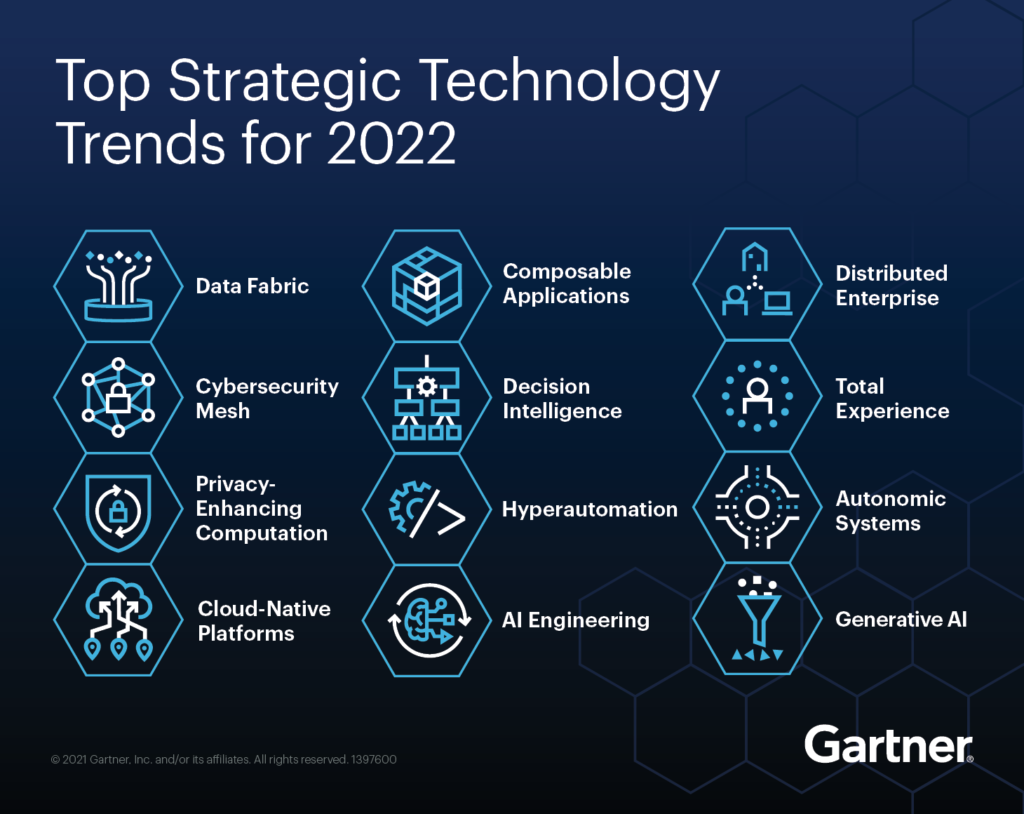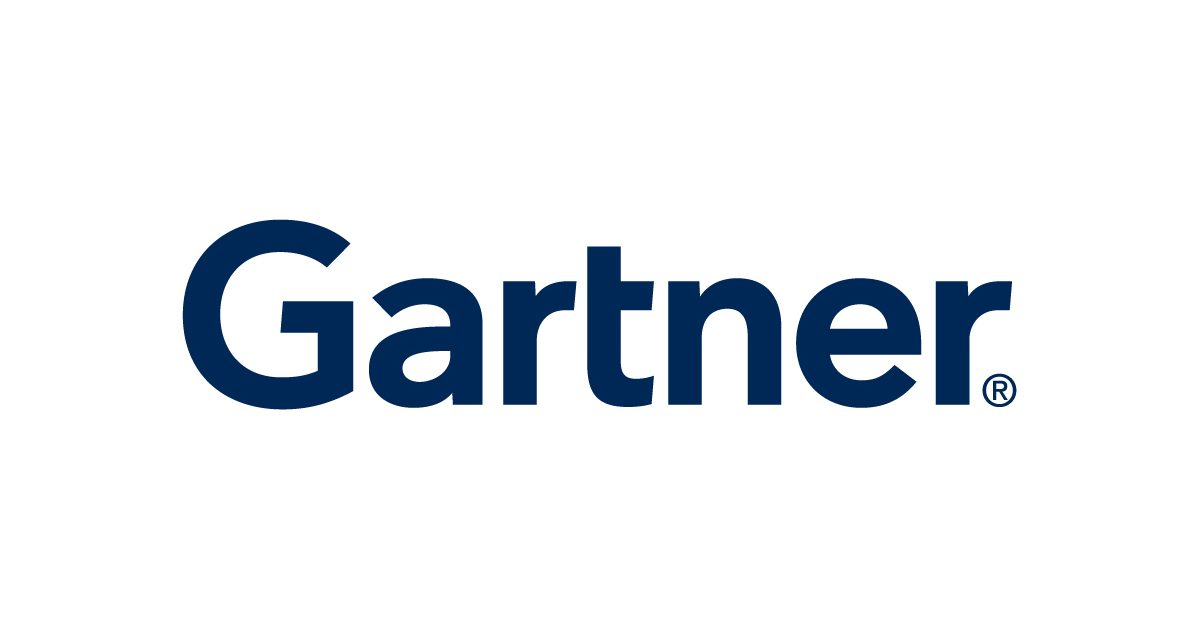การ์ทเนอร์ อิงค์ เผยเทรนด์เทคโนโลยีมาแรงที่องค์กรธุรกิจต้องจับตาดูและศึกษาเพื่อรับมือกับการเปลี่ยนแปลงในปีหน้า
นายเดวิด กรูมบริดจ์ นักวิจัยอาวุโสของการ์ทเนอร์ กล่าวว่า “ความมุ่งมั่นของซีอีโอและบอร์ดบริหารที่ต้องการสร้างการเติบโตแก่องค์กรผ่านการเชื่อมต่อเทคโนโลยีดิจิทัลต่าง ๆ ร่วมกับลูกค้าโดยตรงเป็นภารกิจสำคัญของผู้บริหารด้านไอทีที่ต้องวางแผนและดำเนินการให้ไปในทิศทางเดียวกัน ซึ่งสามารถพิจารณาและปรับใช้แต่ละแนวโน้มเทคโนโลยีเชิงกลยุทธ์ที่มาแรงในปี 2565 ของการ์ทเนอร์ได้”
“ผู้บริหารไอทีต้องหาตัวคูณที่เป็นกำลังสนับสนุนด้านไอทีเพื่อสร้างการเติบโตแก่องค์กรและสร้างสรรค์นวัตกรรม ตลอดจนสร้างรากฐานทางเทคนิคที่มีความยืดหยุ่น ปรับขนาด และสร้างสภาพคล่องทางการเงินในด้านการลงทุนดิจิทัลได้ ส่งผลให้เกิดเทรนด์เทคโนโลยีในปีนี้เป็น 3 ธีมหลัก ๆ ได้แก่: ความน่าเชื่อถือทางวิศวกรรม (Engineering trust) การเปลี่ยนแปลงที่เป็นรูปร่าง (Sculpting change) และการเติบโตอย่างเร่งด่วน (Accelerating growth)”
แนวโน้มเทคโนโลยีเชิงกลยุทธ์มาแรงแห่งปี 2565 ได้แก่

กำเนิดใหม่ปัญญาประดิษฐ์ [Generative Artificial Intelligence (AI)]
หนึ่งในเทคนิคของการพัฒนา AI ที่เป็นที่รู้จักและมีประสิทธิภาพมากที่สุดและกำลังเข้าสู่ตลาดคือ Generative AI ซึ่งเป็นแมชชีนเลิร์นนิ่งที่เรียนรู้เกี่ยวกับคอนเทนท์หรือ Data Object และใช้เพื่อสร้างนวัตกรรมรวมถึงผลิตภัณฑ์ใหม่ ๆ ที่เป็นต้นฉบับและมีความเสมือนจริง
Generative AI สามารถใช้กับกิจกรรมต่าง ๆ อาทิ การสร้างโค้ดซอฟต์แวร์ เร่งกระบวนการพัฒนายาและการทำตลาดที่เน้นกลุ่มเป้าหมายเฉพาะ (Targeted Marketing) อย่างไรก็ดียังพบว่ามีการนำเทคโนโลยีนี้ไปใช้อย่างไม่เหมาะสม เช่น ใช้เพื่อละเมิดทรัพย์สินทางปัญญาผู้อื่น ปลอมแปลงข้อมูลประจำตัว หลอกลวง ฉ้อโกง บิดเบือนข้อมูลทางการเมือง และอื่น ๆ การ์ทเนอร์คาดการณ์ว่า ภายในปี 2568 เทคโนโลยี Generative AI จะมีสัดส่วนเป็น 10% ของข้อมูลทั้งหมดที่ได้รับการผลิตขึ้นมา สูงกว่าปัจจุบันที่มีปริมาณน้อยกว่า 1%
โครงข่ายข้อมูล [Data Fabric]
จำนวนข้อมูลและแอปพลิเคชันแบบไซโลเพิ่มขึ้นในช่วงทศวรรษที่ผ่านมา ขณะที่จำนวนบุคลากรที่มีทักษะในด้านข้อมูลและการวิเคราะห์ (Data and Analytics – D&A) กลับคงที่หรือลดลง
Data Fabric ซึ่งเป็นเทคโนโลยีการรวมข้อมูลที่ยืดหยุ่นและรองรับการทำงานระหว่างแพลตฟอร์มและระหว่างธุรกิจได้รับการพัฒนาขึ้นมาเพื่อทำให้โครงสร้างพื้นฐานในการรวมข้อมูลขององค์กรง่ายขึ้น และสร้างสถาปัตยกรรมที่พร้อมสำหรับการขยายขนาดซึ่งจะช่วยแก้ปัญหาสะสมทางเทคนิคที่เกิดขึ้นหรือที่เราเรียกกันว่า “หนี้ทางเทคนิค” (Technical Debt) ซึ่งพบบ่อยในทีม D&A โดยปัญหาส่วนใหญ่เกิดจากความท้าทายในการรวมข้อมูลที่เพิ่มขึ้นเข้าด้วยกัน
ประสิทธิภาพที่แท้จริงของ Data Fabric คือความสามารถในการปรับปรุงการใช้ข้อมูลแบบไดนามิกด้วยการวิเคราะห์ภายในตัวมันเอง ลดความซับซ้อนในการจัดการข้อมูลได้มากถึง 70% ซึ่งช่วยให้ใช้เวลาได้อย่างคุ้มค่า
องค์กรแบบกระจาย [Distributed Enterprise]
ด้วยปัจจุบันรูปแบบการทำงานระยะไกลและไฮบริดที่เพิ่มมากขึ้น เช่นเดียวกันกับองค์กรที่เคยเน้นการทำงานในออฟฟิศเป็นศูนย์กลางก็ปรับตัวไปสู่องค์กรแบบกระจาย (Distributed Enterprise) ที่รองรับรูปแบบการทำงานที่มีความยืดหยุ่นมากขึ้น และเปิดโอกาสให้พนักงานสามารถทำงานได้จากทั้งในออฟฟิศและนอกสถานที่
กรูมบริดจ์ กล่าวว่า “การเปลี่ยนแปลงนี้ทำให้ผู้บริหารไอทีต้องปรับเปลี่ยนเทคนิคและการบริการที่สำคัญเพื่อมอบประสบการณ์การทำงานที่ราบรื่น อย่างไรก็ดีเหรียญมักมีสองด้านเสมอ เพราะรูปแบบการทำงานดังกล่าวอาจส่งผลกระทบต่อโมเดลธุรกิจ ไม่ว่าจะองค์กรใด ตั้งแต่กลุ่มค้าปลีกไปจนถึงกลุ่มองค์กรทางด้านการศึกษาที่จำเป็นต้องปรับกลยุทธ์และสร้างประสบการณ์ใหม่เพื่อรองรับการทำงานในรูปแบบกระจายเช่นนี้ เพราะคนทั้งโลกไม่เคยมีใครคาดมาก่อนว่าภายในช่วงเวลาแค่สองปีเราต้องเปลี่ยนการไปลองเสื้อผ้าที่ร้านไปเป็นการลองผ่านระบบดิจิทัลแทน”
การ์ทเนอร์คาดการณ์ว่าภายในปี 2566 75% ขององค์กรที่ใช้ประโยชน์จากการสร้างประสบการณ์ทำงานในรูปแบบกระจายจะมีรายได้เร็วเติบโตไวกว่าคู่แข่ง 25%
แพลตฟอร์ม Cloud-Native (CNPs)
เพื่อนำเสนอความสามารถด้านดิจิทัลได้อย่างแท้จริงจากทุกที่ องค์กรจำเป็นต้องทิ้งกลยุทธ์การถ่ายโอนการทำงานแบบเดิม “ยกและเปลี่ยนใหม่” ไปสู่ CNP โดยการปรับใช้ CNP นั้นจะใช้ความสามารถหลักของคลาวด์คอมพิวติ้งเพื่อสร้างบริการในรูปแบบ “As A Service” ซึ่งจะเพิ่มความสามารถแก่ระบบไอทีให้มีความยืดหยุ่นและรองรับการปรับขยายให้แก่บริษัทเทคโนโลยีที่ใช้เทคโนโลยีอินเทอร์เน็ต รวมทั้งเพิ่มมูลค่าจากการส่งมอบผลิตภัณฑ์และบริการไปยังตลาดและผู้บริโภคได้รวดเร็วกว่า ขณะที่ลดต้นทุนไปพร้อมกัน
การ์ทเนอร์คาดการณ์ว่าภายในปี 2568 แพลตฟอร์ม Cloud-Native จะทำหน้าที่เป็นเทคโนโลยีหลักที่เป็นรากฐานสำหรับการสร้างนวัตกรรมหรือเครื่องมือดิจิทัลใหม่ ๆ มากถึง 95% เพิ่มขึ้นจากเดิมที่น้อยกว่า 40% ในปี 2564
ระบบอัตโนมัติขั้นกว่า (Autonomic Systems)
เมื่อองค์กรเติบโตขึ้น การเขียนโปรแกรมแบบดั้งเดิมหรือใช้ระบบอัตโนมัติแบบเก่าอาจไม่ตอบโจทย์ Autonomic Systems เป็นระบบทางกายภาพหรือระบบซอฟต์แวร์ที่สามารถจัดการและเรียนรู้สภาพแวดล้อมของการใช้งานได้ด้วยตนเอง จะต่างจากระบบอัตโนมัติทั่ว ๆ ไป หรือระบบอัติโนมัติที่ไม่ต้องอาศัยมนุษย์ควบคุม (Autonomous System) โดย Autonomic Systems สามารถปรับเปลี่ยนอัลกอริธึมของตัวเองได้แบบไดนามิก ไม่ต้องอัปเดตซอฟต์แวร์ภายนอก ทำให้สามารถปรับให้เข้ากับเงื่อนไขหรือการเปลี่ยนแปลงใหม่ ๆ ได้อย่างรวดเร็ว ในรูปแบบเดียวกับที่มนุษย์สามารถทำได้
“ระบบ Autonomic ได้ถูกปรับใช้กันแพร่หลายในปัจจุบันตามสภาพแวดล้อมการรักษาความปลอดภัยที่ซับซ้อน แต่ในระยะยาวระบบนี้จะกลายเป็นเรื่องธรรมดาที่เกิดขึ้นทั่วไปในแบบที่จับต้องได้ เช่น หุ่นยนต์ โดรน เครื่องจักรที่ใช้ในภาคการผลิต และพื้นที่อัจฉริยะ” กรูมบริดจ์ กล่าว
การตัดสินใจอัจฉริยะ [Decision Intelligence (DI)]
ความสามารถในการตัดสินใจขององค์กรมีความจำเป็นมากยิ่งขึ้น เนื่องจากเป็นทรัพยากรเชิงกลยุทธ์สำคัญที่สามารถสร้างความได้เปรียบทางการแข่งขันให้องค์กรได้
โซลูชั่นที่เพิ่มความสามารถในการตัดสินใจได้อัจฉริยะ (Decision Intelligence) เป็นแนวทางปฏิบัติที่นำไปใช้ได้จริงเพื่อเพิ่มความสามารถในการตัดสินใจโดยการทำความเข้าใจอย่างถ่องแท้ รวมทั้งการออกแบบวิธีการตัดสินใจ และประเมินผลลัพธ์ จัดการ และปรับปรุงจากคำติชมได้ การ์ทเนอร์คาดการณ์ว่าในอีก 2 ปีข้างหน้า หนึ่งในสามขององค์กรขนาดใหญ่จะใช้การตัดสินใจอัจฉริยะเป็นโครงสร้างในการตัดสินใจเพื่อเพิ่มความได้เปรียบในการแข่งขัน
แอปพลิเคชั่นแบบประกอบแยกส่วน (Composable Applications)
ในบริบทของทางธุรกิจที่เปลี่ยนแปลงอย่างต่อเนื่อง ความต้องการในการปรับตัวทางธุรกิจจะนำองค์กรไปสู่สถาปัตยกรรมเทคโนโลยีที่สนับสนุนการเปลี่ยนแปลงรูปแบบการพัฒนาแอปพลิเคชันที่เน้นความรวดเร็ว ปลอดภัยและมีประสิทธิภาพ ซึ่งสถาปัตยกรรมแอปพลิเคชั่นแบบประกอบแยกส่วน (หรือ Composable application architecture) ได้ช่วยเสริมความสามารถให้กับการปรับตัวดังกล่าว และธุรกิจที่ใช้ปรับใช้แนวทางดังกล่าวจะนำหน้าคู่แข่งถึง 80% ในด้านความเร็วของการนำเสนอฟีเจอร์ใหม่ ๆ แก่ผู้บริโภค
“ตลอดช่วงการระบาดที่สร้างความปั่นป่วน หลักการทางธุรกิจที่ยืดหยุ่นจะช่วยให้องค์กรสามารถรับมือต่อสถานการณ์การเปลี่ยนแปลงไปอย่างรวดเร็วได้ ซึ่งจำเป็นต่อความยืดหยุ่นและการเติบโตของธุรกิจ หากไม่มีสิ่งนี้ องค์กรสมัยใหม่เสี่ยงที่จะสูญเสียโมเมนตัมของตลาดและความภักดีของลูกค้าไป” กรูมบริดจ์ กล่าว
เครื่องมืออัตโนมัติแบบยิ่งยวด [Hyperautomation]
Hyperautomation ช่วยเร่งเครื่องให้ธุรกิจเติบโตอย่างรวดเร็วและยืดหยุ่นด้วยความสามารถในการแปลผลลัพธ์ เพิ่มประสิทธิภาพการตรวจสอบอย่างรวดเร็ว และทำให้กระบวนการต่าง ๆ เป็นไปโดยอัตโนมัติให้ได้มากที่สุด
“งานวิจัยของการ์ทเนอร์ชี้ให้เห็นว่าทีม Hyperautomation ที่มีประสิทธิภาพสูงให้ความสำคัญกับสามประเด็นหลัก: ได้แก่ 1.การปรับปรุงคุณภาพงาน 2.การเร่งกระบวนการทางธุรกิจ และ 3.การเพิ่มความคล่องตัวในการตัดสินใจ ขณะเดียวกัน ยังพบว่ามีนักเทคโนโลยีทางธุรกิจสนับสนุนความคิดริเริ่มในด้านระบบอัตโนมัติโดยเฉลี่ย 4.2 โครงการ ในปีที่ผ่านมา” กรูมบริดจ์ กล่าว
เพิ่มประสิทธิภาพประมวลผลความเป็นส่วนตัว [Privacy-Enhancing Computation (PEC)]
เนื่องจากการประกาศใช้กฎหมายด้านความเป็นส่วนตัวและการปกป้องข้อมูลระหว่างประเทศที่เพิ่มขึ้น จึงเป็นหน้าที่ของผู้บริหารที่ต้องรักษาความไว้วางใจของลูกค้าที่อาจเกิดจากความกังวลเรื่องความเป็นส่วนตัว โดยการ์ทเนอร์คาดการณ์ว่า 60% ขององค์กรขนาดใหญ่จะใช้เทคนิคการประมวลผลข้อมูลเพื่อเพิ่มความเป็นส่วนตัวอย่างน้อยหนึ่งเทคนิคภายในปี 2568
PEC เป็นเทคนิคการปกป้องข้อมูลส่วนบุคคลและข้อมูลที่มีความละเอียดอ่อน ครอบคลุมการปกป้องตั้งแต่ระดับข้อมูลซอฟต์แวร์หรือฮาร์ดแวร์ การแบ่งปัน การรวบรวม และการวิเคราะห์ข้อมูลอย่างปลอดภัยขณะที่ยังคงปฏิบัติตามข้อกำหนดด้านความเป็นส่วนตัว ปัจจุบันมีการปรับใช้เทคนิคดังกล่าวแล้วในหลายองค์กรจากอุตสาหกรรมที่แตกต่างกันไป เช่นเดียวกับโครงสร้างพื้นฐานพับบลิกคลาวด์ (อาทิ สภาพแวดล้อมการดำเนินการที่เชื่อถือได้)
ตาข่ายความปลอดภัยไซเบอร์ [Cybersecurity Mesh]
กรูมบริดจ์ กล่าวว่า “ในปีนี้นอกจากปริมาณดาต้าที่เพิ่มขึ้นอย่างต่อเนื่อง ดาต้ายังเป็นเทรนด์ที่ถูกพูดถึงกันตลอดทั้งปี แต่ดาต้าจะมีประโยชน์ก็ต่อเมื่อองค์กรต่าง ๆ สามารถนำข้อมูลไปใช้งานได้อย่างถูกต้องและแม่นยำเท่านั้น วันนี้สินทรัพย์และผู้ใช้กระจายตัวอยู่ทุกหนแห่ง หมายความว่าเราไม่สามารถใช้การรักษาความปลอดภัยในรูปแบบเดิม ๆ ได้อีกต่อไป จึงต้องอาศัยสถาปัตยกรรมที่ป้องกันและจัดการภัยคุกคามทางไซเบอร์ในรูปแบบตาข่ายหรือ Cybersecurity Mesh Architecture (CSMA)”
CSMA ช่วยเตรียมโครงสร้างและแนวทางการรักษาความปลอดภัยแบบบูรณาการเพื่อรักษาความปลอดภัยให้กับทรัพย์สินทั้งหมด โดยไม่คำนึงถึงแหล่งของสินทรัพย์ ภายในปี 2567 องค์กรต่าง ๆ ที่นำ CSMA มาใช้บูรณาการเครื่องมือและระบบรักษาความปลอดภัยต่าง ๆ เพื่อให้สามารถทำงานเป็นระบบนิเวศแบบมีส่วนร่วมจะช่วยลดผลกระทบทางการเงินจากเหตุการณ์ด้านความปลอดภัยส่วนบุคคลได้เฉลี่ยถึง 90%
ปัญญาประดิษฐ์ทางวิศวกรรม [AI Engineering]
ผู้นำด้านไอทีติดปัญหาในการผสานรวมระบบ AI เข้ากับแอปพลิเคชัน ทำให้เสียเวลาและเงินไปกับโครงการ AI ที่ไม่เคยนำไปสู่การผลิต หรือการพยายามรักษาคุณภาพของโซลูชัน AI เมื่อเปิดตัว ซึ่ง AI Engineering เป็นแนวทางแบบบูรณาการสำหรับการดำเนินงานโมเดล AI ในรูปแบบต่าง ๆ
กรูมบริดจ์ กล่าวว่า “สำหรับทีมฟิวชั่นที่ทำงานด้าน AI ตัวสร้างความต่างที่แท้จริงสำหรับองค์กรพวกเขาก็คือความสามารถในการเพิ่มมูลค่าได้อย่างต่อเนื่องผ่านการเปลี่ยนแปลงของระบบ AI อย่างรวดเร็ว ภายในปี 2568 จะพบว่า 10% ขององค์กรที่สร้างแนวปฏิบัติที่ดีที่สุดด้านวิศวกรรม AI จะสร้างมูลค่าเพิ่มอย่างน้อยสามเท่าจากความพยายามปรับใช้ AI หรือมากกว่า 90% ขององค์กรที่ไม่ได้ทำ”
ประสบการณ์เต็มรูปแบบ [Total Experience (TX)]
TX เป็นกลยุทธ์ธุรกิจที่ผสมผสานประสบการณ์ลูกค้า (CX) ประสบการณ์พนักงาน (EX) ประสบการณ์ผู้ใช้ (UX) และประสบการณ์หลากหลาย (Multiexperience – MX) เข้าด้วยกัน เป้าหมายของกลยุทธ์ TX คือการสร้างความมั่นใจ ความพึงพอใจ ความภักดี และการสนับสนุนมากขึ้นจากลูกค้าและพนักงานที่พึงพอใจกับประสบการณ์ที่ได้รับการยกระดับ ขณะเดียวกันองค์กรต่าง ๆ สามารถเพิ่มรายได้และสร้างผลกำไรจากการบรรลุประสิทธิผลทางธุรกิจของ TX ที่ปรับตัวและยืดหยุ่น
แนวโน้มเทคโนโลยีเชิงกลยุทธ์ชั้นนำของปีนี้ได้มุ่งเน้นไปที่แนวโน้มที่จะผลักดันให้เกิดการหยุดชะงักหรือโอกาสการเติบโตในอีก 5-10 ปีข้างหน้า ลูกค้าของการ์ทเนอร์สามารถอ่านรายงานเพิ่มเติมได้ใน “แนวโน้มเทคโนโลยีเชิงกลยุทธ์ประจำปี 2565” พร้อมเรียนรู้เกี่ยวกับข้อมูลด้านเทคโนโลยีของปีนี้ในเชิงลึกได้ที่ Gartner e-book
